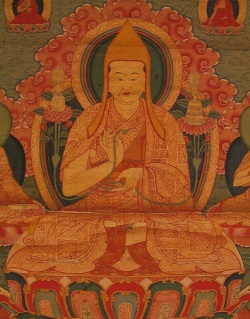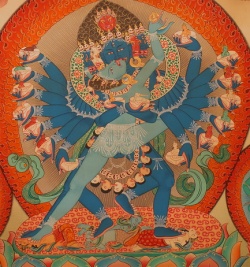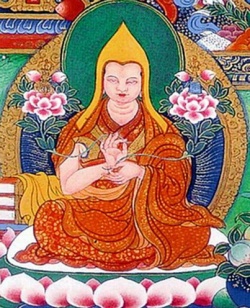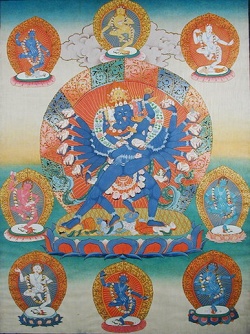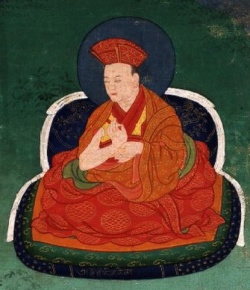Butön Rinchen Drup
Butön Rinchen Drup (Wyl. bu ston rin chen grub) (1290-1364) — a great scholar of the Sarma tradition who compiled the Tibetan Buddhist canon (Kangyur). His lineage is called Shalupa after the name of the place where he mostly resided, Shalu Monastery, near Shigatsé in Central Tibet. His personal writings include a celebrated history of Buddhism (Wyl. bu ston chos byung).
Buton Rinchen Drub (bu ston rin chen grub) was born in 1290, the iron-tiger year of the fifth sexagenary cycle, to a family associated with a monastery named Sheme Gomne (shad smad sgom gnas) in the Tropu (khro phu) area of Tsang. His father was a prominent Nyingma Lama named Drakton Gyeltsen Pelzang (brag ston rgyal btshan dpal bzang, d.u.). His mother, also a Nyingma master, was called Sonam Bum (bsod nams 'bum, d.u.).
He began his studies of reading and writing at age five or six under the tutorship of his mother, and continued to study mathematics, reading and writing under a teacher named Gyamseng (rgyam seng, d.u.). He received medical training, teachings on Guhyasamāja, Dzogchen, and other topics from his grandfather, a Nyingma lama named Tsultrim Pelzang (tshul khrims dpal bzang, d.u.), who belonged to the Nub (snubs) tradition.
At the age of eighteen he was granted both novice and primary monastic vows by Tropu Khenchen Rinchen Sengge (khro phu mkhan chen rin chen seng+ge, d.u.) and Geshe Sonam Gon (dge bshes bsod nams mgon, d.u.), also known as Ācārya Riktikpa (rigs thig pa). Geshe Sonam Gon taught him topics relating to the Prajñāpāramitā, Vinaya, and logic, as well as esoteric oral instructions (man ngag) from the Dzogchen tradition. Rinchen Drub is said to have mastered multiple versions of the Prajñāpāramitā, the Pañcaviṃśatisāhisrikāloka, the Yogācārabhūmi, the Mahāyānasaṃgraha, the Abhidharmasamuccaya, the Pramāṇasamuccaya, the Pramāṇaviniścaya, and other Sanskrit classics. Additionally, Tropu Khenchen gave him empowerments and transmissions of many tantric systems of practice, including Cakrasaṃvara, Yamāntaka, Bhairava, Vajrapāṇi, Tārā, Vārāhī, Vidāraṇa, Amitāyus, Mahāmudrā, Mahākāruṇika, and others.
Rinchen Drub studied with many other masters. Dondrub Pel (don 'grub dpal, d.u.) gave him teachings on Hevajra, the Prajñāpāramitā, and the Śikṣāsamuccaya; Kabzhipa Konchok Zhonnu[[]] (bka' bzhi pa dkon mchog gzhon nu, d.u.) gave him empowerments from the Kadam tradition of Avalokiteśvara; Tishri Kunzang (ti shri kun bzang, d.u.) taught him Madhyamaka; and his father gave him teachings on the Kriyā Tantra of the Subterranean Vajra (rdo rje sa 'og gi rgyud) and Vajrapāṇi. He received additional tantric transmissions and empowerments from many other teachers whose names include Pelden Sengge (dpal ldan seng ge, d.u.), Dorje Gyeltsen (rdo rje rgyal mtshan, d.u.), Tokden Sorin (rtogs ldan bsod rin, d.u.), and Namnangwa Yonten Gyatso (rnam snang ba yon tan rgya mtsho, d.u.). He traveled across U and Tsang with his father, receiving teachings from many masters and earning a reputation as a brilliant student. Later in life he also studied with the Kadam master Kumārasiddhi, who was a student of Jam Lingpa (byams gling pa, d.u.)
In 1312, at the age of twenty-three, he was given full ordination at Tsongdu Gurmo (tshong 'dus 'gur mo) in the presence of twenty learned masters, including Zhonnu Pelzang (gzhon nu dpal bzang, d.u.), who was a student of Śākyaśrībhadra; Sonam Drak (bsod nams grags, d.u.); and his student Sonam Zangpo (bsod nams bzang po, d.u.). For the occasion, Zhonnu Pelzang gave Rinchen Drub teachings on the Prātimokṣa, and Sonam Drak taught him commentaries on the Vinayamūlasūtra and the Ekottarakarmaśataka. During this time, Rinchen Drub would study during the day and meditate in the evenings.
Soon afterwards, he traveled to Tarpa Ling (thar pa gling) where he studied Sanskrit poetry and grammar for about four years with Tarpa Lotsāwa Nyima Gyeltsen (thar pa lo tsA ba nyi ma rgyal mtshan, d.u), a prominent translator whom Rinchen Drub came to consider the chief among his many teachers. Tarpa Lotsāwa also gave him transmissions from Kālacakra, Hevajra, and other traditions. At Rong, he studied grammar and Kālacakra with Dorje Gyeltsen Pelzang (rdo rje rgyal mtshan dpal bzang, d.u), the nephew of Lama Sherab Sengge]] (bla ma she rab seng ge, d.u.).
Afterwards, he began to teach and, apparently, proselytize. According to his disciple and biographer Rinchen Namgyel (rin chen rnam rgyal, 1318-1388), Rinchen Drub "overcame proponents of false and wicked views, including the Bon, by means of scriptural texts and reasoning, and converted them to Buddhism." He gave ordination to a number to students, and began to compose his own works, assisted by his disciples Neng Sengge Yeshe Pel ([[sneng seng ge [ye shes dpal]], d.u.) and Dargye (dar rgyas, d.u.).
In 1320, at the age of thirty-one, he was installed as the eleventh abbot of Zhalu (zhwa lu) by Kuzhang Drakpa Gyeltsen (sku zhang grags pa rgyal mtshan, d.u.), a member of the area's ruling family. Drakpa Gyeltsen had been rebuilding the temple, which was founded in 1040 by Chetsun Sherab Jungne (lce btsun shes rab 'byung gnas, d.u.). With the backing of Drakpa Gyeltsen and his family, Rinchen Drub greatly expanded Zhalu, constructing new stupas and temples. Because of this reconstruction, later enumerations of the abbots of Zhalu count Buton as the first abbot. His tradition of teaching is alternately known as the Zhaluk or the Buluk.
Rinchen Drub continued to seek out and receive teachings, particularly from the Sakya tradition, from various masters including a lama named Pakpa ('phags pa); Chokyi Gyeltsen Pelzang (chos kyi rgyal mtshan dpal bzang, 1332-1239); Kunga Gyeltsen (kun dga' rgyal mtshan, 1310-1358), who was the precepter to the emperor of China at the time; Donyo Gyeltsen (don yod rgyal mtshan, d.u.) and Sonam Gyeltsen (bsod nams rgyal mtshan, 1312-1375). It is said he studied with a total of twenty-eight masters.
At Zhalu, Rinchen Drub established a college for the study of sūtra-based philosophy and the new tantras that were arriving in Tibet. During the summer and winter months he would teach Prajñāpāramitā, Abhidharma-samuccaya, Pramāṇaviniścaya, the Bodhicaryāvatāra, and the Vinaya from the sūtra tradition. In the spring and autumn months, he taught the Kālacakra, Guhyasamāja, from the tantra tradition, along with other subjects. He wrote numerous treatises on all of these topics.
At Zhalu Rinchen Drub was also involved in the production of what later served as a foundation for many extant editions of the Tibetan canon. Buton is known to have worked from a collection of scripture generally known as the Old Nartang (snar thang) edition of the Kangyur (bka' 'gyur) and Tengyur (bstan 'gyur). This had been created at Nartang Monastery in the early fourteenth century under the supervision of the Kadam monk Jamyang ('byams dbyangs), who had served in the court of the Yuan Emperor Renzong 仁宗 (r. 1311-1320). (It is referred to as a the "Old Nartang" to differentiate from a later block print edition out of Nartang monastery.) The Old Nartang edition, which was in manuscript, established the Tibetan separation of the Kangyur, containing the words of (or inspired by) the Buddha, and the Tengyur, containing the commentaries and treatises of Indian and other non-Tibetan masters. No longer extant, scholars believe that the Old Nartang was a collection of available manuscripts rather than a new edition of the scriptures.
Buton is considered to have been at the center of one of two efforts to edit and expand the Old Nartang (the other project was based at Tsel Gungtang Monastery, under the sponsorship of the local ruler Tselpa Kunga Dorje, during the year 1347-1351). He completed both a Kangyur and a Tengyur. With the patronage of Drakpa Gyeltsen, he invited to Zhalu scholars and scribes to work on the project. His Tengyur numbered 3392 texts and was done over the winter of 1334-1335. Details on the Kangyur are lacking.
Buton famously excluded from his Kangyur the Nyingma tantras, which he considered to be inauthentic, which is to say, not the words of the Buddha. This claim was based on the inconsistently invoked Tibetan standard by which a purportedly translated scripture was deemed authentic only when an Indic original was attested. Both Tibetan and western scholars have suggested that Buton, working in an era of institutional prejudice against the Nyingma tradition, used the standard selectively. For example, despite its continued importance in his own Sakya tradition and the existence of Sanskrit material attesting to its Indic origin, he excluded the Vajrakīla, a tantric system that dated back to Imperial times which was regarded by some partisans as belonging to a corrupted Nyingma tradition. In the Blue Annals Go Lotsāwa Zhonnu Pel ('gos lo tsA ba gzhon nu dpal, 1392-1481) criticized Buton for excluding the Guhyamūla Tantra from the Kangyur, despite the fact that he did include in the Tengyur Vajrahāsa's Guhyasamājaṭīka, which quotes extensively from that tantra.
According to one of his biographers, Rinchen Namgyel, Buton also sponsored drawings of the past lives of the Buddha, the Buddha's Twelve Deeds, other episodes from the Buddha's life, as well as on tantric themes. His list of the Eighty-four Mahāsiddhas established one of the common enumerations of this topic.
In 1344, at the age fifty-five, he gave teachings at Sakya monastery (dpal sa skya) at the request of Sonam Gyeltsen Pelzang (bsod nams rgyal mtshan dpal bzang, d.u.). While there, he received invitations to visit the courts of the Yuan Emperor Huizong 惠宗, Toghan Temur (r. 1333-1370) and the Nepalese king Puṇyamalla, but declined both of them. The invitations reflect not only Rinchen Drub's growing fame, but also the ongoing close relationship between the Sakya tradition and their patrons, the Yuan Dynasty in China.
While at Sakya, he worked on translating a number of scripture and commentaries, including the explanatory tantra of the Guhyasamāja (dpal gnyis su med pa rnam par rgyal ba'i rgyud chen po), the Sekoddeśapañjika, the Vajrāmṛtapañjikā, and edited previous translations. He continued to translate and edit through the end of his life.
At the age of sixty-two, he again went to U, apparently to mediate a dispute between the Yabzang (g.ya' bzang), allied with the Drigung Kagyu ('bri gung), and the Pakmodru (phag mo gru), two of the thirteen myriarchies (khri skor) of the Yuan era, which were nominally under Sakya authority. Along the way, he gave teachings, empowerments, transmissions, and ordination to numerous monks at monasteries such as Ralung (rwa lung) and Nangto Chumik (nyang stod cho mig). He traveled for several years, during the coarse of which he visited the home monastery of his first teacher, Tropu Khenchen Rinchen Sengge.
He then returned to Sakya, and in 1354, at the age of sixty-five traveled, again to Zhalu. He stayed for about one year and once again went to Sakya. There, he constructed a mandala of Sarvakulasaṃgraha of the Śrīparamādya Tantra with Chokyi Gyeltsen Pelzang. Although repeatedly asked to teach at Sakya, his relationships with other masters there were not without controversy. Claiming to be the reincarnation of the Sakya patriarch Jetsun Drakpa Gyeltsen (rje btsun grags pa rgyal mtshan, 1147-1216), Buton rewrote several passages from Drakpa Gyeltsen's works, to the consternation of other Sakya scholars.
In 1356, he stepped down as abbot of Zhalu after serving for thirty-seven years. His disciple, Rinchen Namgyel, succeeded him as abbot. At the time Zhalu is said to have had 3,800 monks living and studying within its walls.
Rinchen Drub retired to Ripuk (ri phug), a hermitage connected to Zhalu that he had developed on a site that Atisha Dīpaṃkara had visited. There, he continued to teach and receive teachings. It is possible that he wrote his famed History of Buddhism ([[bde gshegs bstan pa'i gsal byed chos kyi 'byung gnas) at this time. In 1357, the Kashmiri paṇḍita Sumanaśrī arrived and gave him teachings on new Indian scriptures, including the Padmajāla, which Rinchen Drub subsequently translated. He gave teachings on the Kālacakra to the Sakya lamas Kunga Rinchen Gyeltsen Pelzang (kun dga' rin chen rgyal mtshan dpal bzang, d. 1399), Jangchub Gyeltsen Tai Situ ('byang chu rgyal mtshan tai si tu) and Jamyang Śākya Gyeltsen Pelzang ('jam dbyangs shAkya rgyal mtshan dpal bzang). He also continued to travel, going to Bodong E to consecrate a new temple and meet with Gyelse Tokme (rgyal sras thogs med, 1295-1369).
Other prominent students of Buton included the fifth abbot of Jonang, Chokle Namgyel (phyogs las rnam rgyal, 1306-1386); Chunyi Sarma Drakpa Sherab (bcu gnyis gsar ma grags pa shes rab, 1310-1370); the Second Gankar Lama, Rinchen Zangpo (gangs dkar bla ma 02 rin chen bzang po, 1317-1383); Drakpa Gyeltsen, who succeeded him as abbot of Zhalu (zhwa lu mkhan chen 02 grags pa rgyal mtshan, 1365-1448); Yungton Dorje Pel (g.yung ston rdo rje dpal, 1284-1365); and Yakde Paṇchen Tsondru Dargye (g.yag sde paN chen brtson 'grus dar rgyas, 1299-1378).
In early 1364, Rinchen Drub fell ill and entered retreat. He passed away on the twenty-first day of the sixth month of the wood-dragon year.
His disciple Rinchen Namgyel wrote his biography in two parts. The first was written in 1355 when Buton was sixty-six and stepping down from the abbacy of Zhalu. The second was written in 1366 and chronicled the final years of his life.
Woodblocks for Buton's writings were first carved in 1917 under the orders of the Thirteenth Dalai Lama. Most editions now have twenty-eight volumes.
Sources
Blo bzang chos grang and Bsod nams rtse mo. 1988. Gang ljongs mkhas dbang rim byon gyi rtsom yig gser gyi sbram bu. Xining: Mtsho sngon mi rigs dpe sprun khang.
Blo gros don yod. 2005. Bu ston rin chen grub kyi rnam thar. In Dus 'khor chos 'byung in+dra nI la'i phra tshom, vol. 1, pp. 628-637. Mirik: 'Bo dkar nges don chos 'khor gling gi bla spyi spar bskrun zhus. TBRC W00EGS1016994.
Blo gsal bstan skyong. 1971. Zhwa lu gdan rabs. Leh: S.W. Tashigangpa, p. 8.
Bu ston rin chen grub. 1988. Bu ston chos 'byung. Xining: Krung go'i bod gyi shes rig dpe sprun khang, pp. 318-374.
Dratshadpa Rinchen Namgyal. 1996. Hans Van den Bogaert, trans. A Handful of Flowers: A Brief Biography of Buton Rinchen Drub. Dharamsala: Library of Tibetan Works and Archives.
Gonpo Pal. N.d. Chos kyi rje 'jam pa'i dbyangs bu ston kha che'i rnam par thar pa rin po che'i phreng ba. Manuscript. TBRC W26457.
Grags pa 'byung gnas and Rgyal ba blo bzang mkhas grub. 1992. Gangs can mkhas grub rim byon ming mdzod. Lanzhou: Kan su'u mi rigs dpe skrun khang, pp. 1083-1085. TBRC W19801.
Gzhon nu bsod nams. N.d. Thams cad mkhyen pa bu ston rin po che'i rnam par thar pa yon tan rin po che'i lhun po. Manuscript. TBRC W26456.
Harrison, Paul. 1996. "A Brief History of the Tibetan bKa' 'gyur." In Tibetan Literature: Studies in Genre. Cabezon, José Ignacio Cabezón and Roger Jackson, eds. Ithaca, Snow Lion, pp. 70-89.
Nor brang o rgyan. 2006. Bu ston rin chen grub. In Gsung rtsom / nor brang o rgyan, pp. 628-632. Beijing: K rung go'i bod rig pa dpe skrun khang. TBRC W1GS66291.
Rin chen rnam rgyal. 1366. Chos rje thams cad mkhyen pa bu ston rin po che'i rnam thar. Blockprint. TBRC W26455.
Rin chen rnam rgyal. 1988. Chos rje thams cad mkhyen pa bu ston lo tsA ba'i rnam par thar pa snyim pa'i me tog. In Bde gshegs bstan pa'i gsal byed chos kyi 'byung gnas, pp. 334-390. Beijing: Krung go bod kyi shes rig dpe skrun khang. TBRC W1923.
Rinchen Namgyal. 1996. Hans Van Der Bogaert, trans. A Handful of Flowers: A Brief Biography of Buton Rinchen Drub. Dharamsala: Library of Tibetan Works and Archives.
Ruegg, David Seyfort. 1966. The life of Bu ston Rin po che: With the Tibetan text of the Bu ston rNam thar. Roma: Instituto italiano per il Medio ed Estremo Oriente, 1966.
Roerich, George, trans. 1996. The Blue Annals. 2nd ed. Delhi: Motilal Banarsidas.
Schaeffer, Kurtis R. 2004. "A letter to the editors of the Buddhist canon in fourteenth-century Tibet: the yig mkhan rnams la gdams pa of Bu ston Rin chen grub." The Journal of the American Oriental Society, vol. 124, no. 2, pp. 265-280.
Schaeffer, Kurtis R. 2009. The Culture of the Book in Tibet. New York: Columbia University Press.
ShAkya dpal. N.d. Rin chen rnam rgyal gyi rnam par thar pa snyim pa'i me tog las 'khrungs pa ngo mtshar ze 'bru'i nor bu. TBRC W26458.
Skal bzang rgyal po. 1987. Chos rje thams cad mkhyen pa bu ston lo ts+tsha ba'i rnam par thar pa snyim pa'i me tog. In Zha lu dgon gyi lo rgyus mdor bsdus, vol. 1, pp. 57-165. Lhasa: Bod ljongs mi dmang dpe skrun khang. TBRC W20840.
Skal bzang rgyal po. 1987. Thams cad mkhyen pa bu ston rin chen grub kyi rnam thar mdor bsdus. In Zha lu dgon gyi lo rgyus mdor bsdus, vol. 1, pp. 33-42. Lhasa: Bod ljongs mi dmang dpe skrun khang. TBRC W20840.
Tsering Namgyal
September 2012
